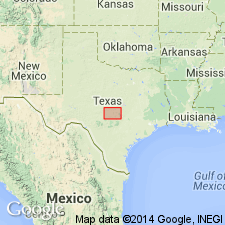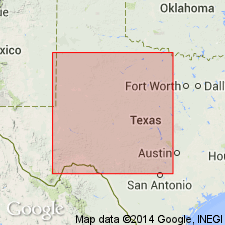
- Usage in publication:
-
- Smithwick shale
- Modifications:
-
- Revised
- AAPG geologic province:
-
- Bend arch
- Llano uplift
Summary:
Smithwick shale revised--assigned as topmost of three formations of Bend group (rank changed from division) in north-central TX. Bend group consists of (ascending): newly named Barnett shale, Marble Falls limestone, and Smithwick shale. Smithwick conformably overlies Marble Falls limestone of Bend group; underlies rocks of Strawn group (revised). Occurs all along the outcrop around the Llano Mountains, and recently an outlier was found in a synclinal area 9 mi south of the Marble Falls-Smithwick contact due south of Richland Springs. Also occurs above Marble Falls limestone throughout a very large area, north, east, and west of the Llano region, for it is reported in practically every well which has been drilled to the proper horizon. It may be conceived to underlie all of the north-central TX area. Average thickness is about 450 ft. Fossils listed and discussed. Is of Early Pennsylvanian (lower Pottsville) age.
Source: GNU records (USGS DDS-6; Denver GNULEX).

- Usage in publication:
-
- Smithwick group
- Modifications:
-
- Revised
- AAPG geologic province:
-
- Bend arch
Summary:
Revised--Smithwick beds are excluded from Morrow and Strawn series and assigned to the intervening Lampasas series (new name, this report); classification of Smithwick as a group of Lampasas series is suggested. 3 mappable formations of Smithwick in Bend flexure area are here named (ascending): Eastland Lake formation, Caddo Pool formation, and Parks formation. Well cuttings from the Anzac Oil Corp. et al, E. S. Graham No. 1, located in the Allen Hines Survey, Abstract 135, Young Co, TX on the Bend arch designated to serve as a type section for the formations of Smithwick group; includes strata from depths of 4,225 to 3,626 ft. Smithwick overlies Big Saline group (new); underlies Millsap Lake group in Strawn series with pronounced unconformity. Is of Pennsylvanian age. Log sections. Stratigraphic chart.
Source: GNU records (USGS DDS-6; Denver GNULEX).
For more information, please contact Nancy Stamm, Geologic Names Committee Secretary.
Asterisk (*) indicates published by U.S. Geological Survey authors.
"No current usage" (†) implies that a name has been abandoned or has fallen into disuse. Former usage and, if known, replacement name given in parentheses ( ).
Slash (/) indicates name conflicts with nomenclatural guidelines (CSN, 1933; ACSN, 1961, 1970; NACSN, 1983, 2005, 2021). May be explained within brackets ([ ]).

